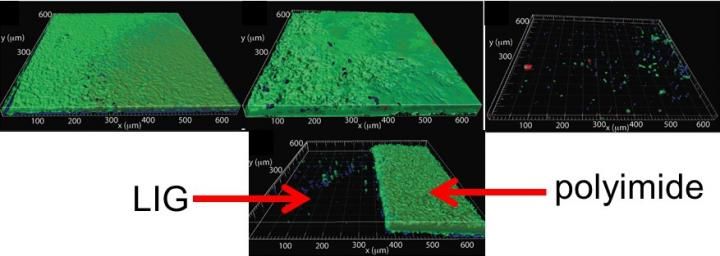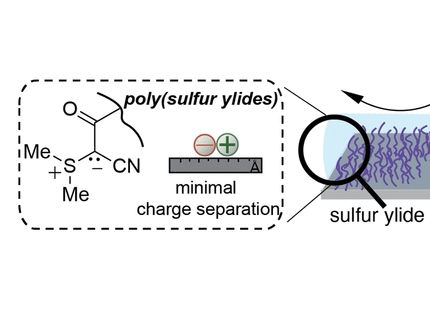Zap! Graphene is bad news for bacteria
Scientists at Rice University and Ben-Gurion University of the Negev (BGU) have discovered that laser-induced graphene (LIG) is a highly effective anti-fouling material and, when electrified, bacteria zapper.

In the top row, the growth of biofilm on surfaces with a solution containing Pseudomonas aeruginosa is observed on, from left, polyimide, graphite and laser-induced graphene surfaces. Green, red and blue represent live bacteria, dead bacteria and extracellular polymeric substances, respectively. At bottom, a sheet of polyimide burned on the left to leave laser-induced graphene shows the graphene surface nearly free of growth.
Arnusch Lab/Ben-Gurion University of the Negev
LIG is a spongy version of graphene, the single-atom layer of carbon atoms. The Rice lab of chemist James Tour developed it three years ago by burning partway through an inexpensive polyimide sheet with a laser, which turned the surface into a lattice of interconnected graphene sheets. The researchers have since suggested uses for the material in wearable electronics and fuel cells and for superhydrophobic or superhydrophilic surfaces.
According to their report LIG also protects surfaces from biofouling, the buildup of microorganisms, plants or other biological material on wet surfaces.
"This form of graphene is extremely resistant to biofilm formation, which has promise for places like water-treatment plants, oil-drilling operations, hospitals and ocean applications like underwater pipes that are sensitive to fouling," Tour said. "The antibacterial qualities when electricity is applied is a great additional benefit."
When used as electrodes with a small applied voltage, LIG becomes the bacterial equivalent of a backyard bug zapper. Tests without the charge confirmed what has long been known -- that graphene-based nanoparticles have antibacterial properties. When 1.1 to 2.5 volts were applied, the highly conductive LIG electrodes "greatly enhanced" those properties.
Under the microscope, the researchers watched as fluorescently tagged Pseudomonas aeruginosa bacteria in a solution with LIG electrodes above 1.1 volts were drawn toward the anode. Above 1.5 volts, the cells began to disappear and vanished completely within 30 seconds. At 2.5 volts, bacteria disappeared almost completely from the surface after one second.
The Rice lab partnered with Professor Christopher Arnusch, a lecturer at the BGU Zuckerberg Institute for Water Research who specializes in water purification. Arnusch's lab tested LIG electrodes in a bacteria-laden solution with 10 percent secondary treated wastewater and found that after nine hours at 2.5 volts, 99.9 percent of the bacteria were killed and the electrodes strongly resisted biofilm formation.
The researchers suspect bacteria may meet their demise through a combination of contact with the rough surface of LIG, the electrical charge and toxicity from localized production of hydrogen peroxide. The contact may be something like a knee hitting pavement, but in this case, the bacteria are all knee and the sharp graphene edges quickly destroy their membranes.
Fortunately, LIG's anti-fouling properties keep dead bacteria from accumulating on the surface, Tour said.
"The combination of passive biofouling inhibition and active voltage-induced microbial removal will likely make this a highly sought-after material for inhibiting the growth of troublesome natural fouling that plagues many industries," Tour said.
Original publication
Most read news
Other news from the department science

Get the chemical industry in your inbox
By submitting this form you agree that LUMITOS AG will send you the newsletter(s) selected above by email. Your data will not be passed on to third parties. Your data will be stored and processed in accordance with our data protection regulations. LUMITOS may contact you by email for the purpose of advertising or market and opinion surveys. You can revoke your consent at any time without giving reasons to LUMITOS AG, Ernst-Augustin-Str. 2, 12489 Berlin, Germany or by e-mail at revoke@lumitos.com with effect for the future. In addition, each email contains a link to unsubscribe from the corresponding newsletter.





























































